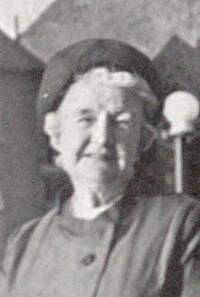Leslie de Barra
Leslie de Barra | |
|---|---|
 | |
| Born | Leslie Price 9 January 1893 |
| Died | 9 April 1984 (aged 91) |
| Nationality | Irish |
| Other names | Leslie Barry, Mrs Tom Barry |
Leslie Mary de Barra (née Price; 9 January 1893 – 9 April 1984) was an Irish
Early life
Born Leslie Mary Price in Dublin in 1893 to Michael and Mary Price. Her father was a blacksmith and she was one of six children. She wanted to be a teacher and by 1911 had become a Monitress, a common way for girls to get into the teaching profession.[2][3] Two of her brothers were involved in the Irish Volunteers and she was a member of Cumann na mBan. In advance of the Rising, with the confusion over orders and lack of information, she stated that she "did not question anything" as, with all that was happening, there were often odd events in her house. But they were all waiting for the mobilisation orders for the Easter Rising.[4]
Easter Rising
De Barra's role during the republican rebellion in Ireland, Easter 1916, was to act as a courier carrying messages and ammunition between the main headquarters in the
After the Rising
By 1918 de Barra represented West Cork in the Cumann na mBan convention and became a member of the executive committee.
De Barra married Tom Barry on 22 August 1921, in Cork during the Truce period in the lead up to the Anglo-Irish Treaty. At the wedding were men who later ended up on opposite sides. Both Éamon de Valera and Michael Collins were guests. Her husband was staunchly Anti-Treaty even though he had been friends with Collins.[12][13] Although her husband was a staunch republican and a major figure in the Irish War of Independence and the Irish Civil War, while she was serving in the GPO in Dublin during the rising he was in Mesopotamia serving the British Army in the First World War.[14]
Humanitarian work
In later years de Barra was central to the
De Barra was instrumental in the setting up of the
In 1956 a memorial to 1916 was unveiled in Limerick. It had been designed by Albert Power and the commemoration of the Rising was held in May 1956 and the monument unveiled by de Barra.[21]
In 1963 de Barra was awarded an honorary degree from University College Dublin along with Éamon de Valera and others.[22]
In 1971 she was part of a series to look back on the events leading to Irish Independence and her story was broadcast by
In 1979 she won the Henry Dunant Medal which is the highest award of the Red Cross Movement.[24]
De Barra and her husband lived in Cork, on St Patrick's street from the 1940s until his death in 1980. She died on 9 April 1984 in Cork and is buried with her husband in St Finbarr's. She is remembered today in the Leslie Bean de Barra Trophy awarded for the Cork Area Carer of the Year.[19]
References
- ISBN 978-0-7171-6614-5.
- ^ "Census return for Murtagh Road, Dublin". National Archives of Ireland.
{{cite web}}: Missing or empty|url=(help) - ISBN 978-0-19-991619-1.
- ^ ISBN 978-1-107-04774-7.
- ISBN 978-1-905172146.
- ^ "A Kildare woman in the GPO". Kildare history.
- ^ ISBN 978-1-85635-684-8.
- ^ "The GPO". Irish Medals. Archived from the original on 16 March 2016. Retrieved 24 March 2016.
- ^ McCarthy, pg 129.
- ISBN 978-1-85635-554-4.
- ISBN 978-1-84717-504-5.
- ^ "Does Tom Barry's wedding photo reveal veiled tensions?". Irish Independent. 1 October 2009.
- ISBN 978-0-9704155-2-3.
- ^ "The Legacy of Cumann na mban".
- ^ a b c "Speech by President Michael D Higgins to commemorate the role of women". President of Ireland Site.
- ^ Meda Ryan (2003). Tom Barry: IRA Freedom Fighter, Cork. Mercier Press. pp. 317–318.
- ^ Liam Ó Ruairc (2015). "Ethics As Analogy".
- ISBN 978-0-312-29416-8.
- ^ a b "Bandon Woman named as Cork Carer of the Year". West Cork People. Archived from the original on 14 April 2016. Retrieved 24 March 2016.
- ^ "1962 Launching of Freedom from Hunger Campaign". Irish Photo Archive.
- ^ "1916 Memorial".
- ^ "Frederick C. Lindvall, William McCausland Stewart, Rev. Paul Henry SJ, Michael Tierney, Seán MacEntee, Éamon de Valera, Leslie de Barra and Emmanuel C. Amoroso at the presentation of honorary degrees, Iveagh House, Dublin". University COllege Dublin. 11 July 1963.
- ^ "Women of the Revolution: Leslie de Barra of Cumann na mBan". RTÉ. 12 April 1971.
- ^ "List of Henry Dunant Medal Winners and their National Societies". Standing commission of the Red Cross and Red Crescent.
